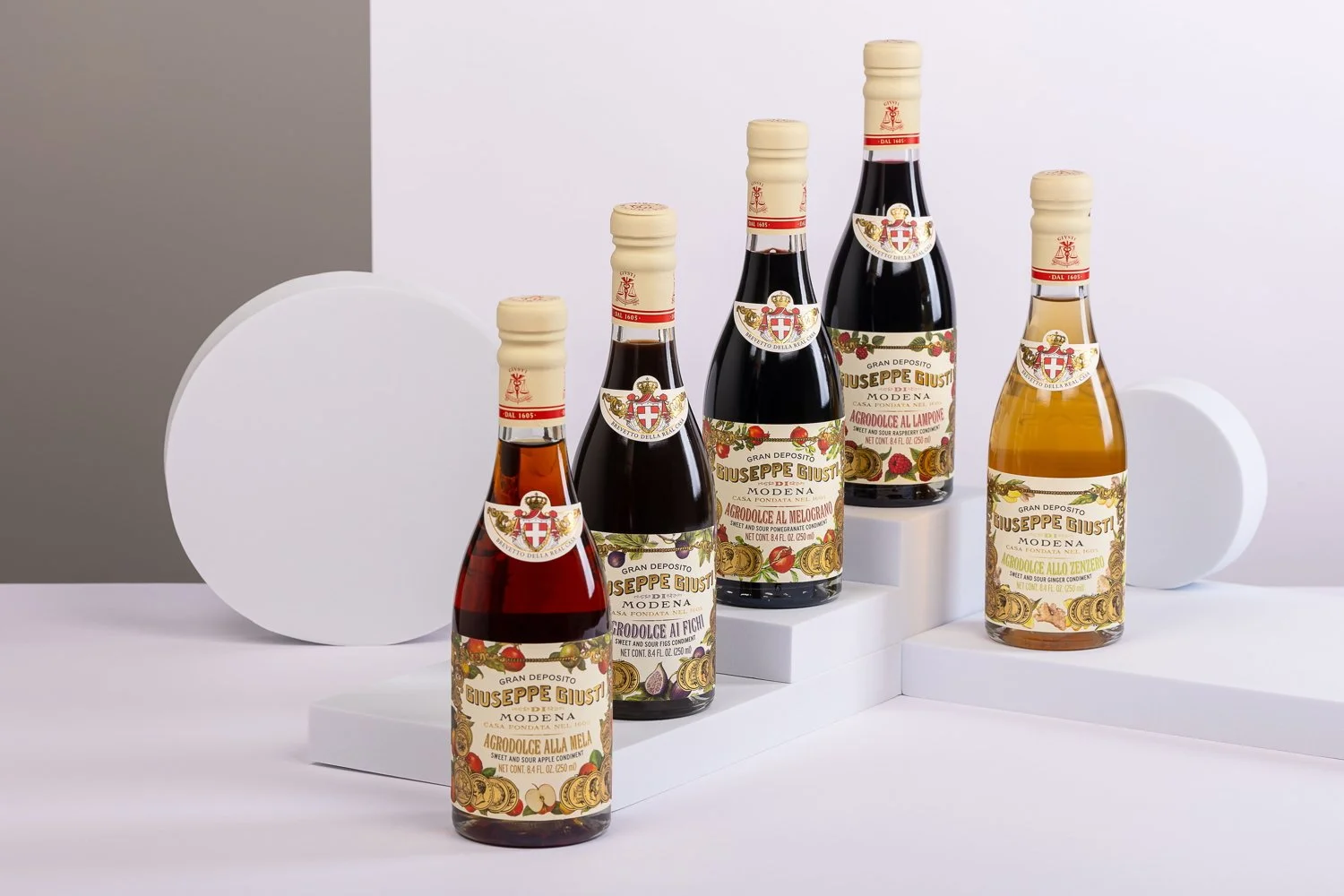The Sweet-And-Sour Vinegar Sensation: Agrodolce Everywhere!
I remember the first time I had sweet-and-sour pork. It was from one of many Chinese takeout places of my childhood. One which you order numerically rather by the name of the dish. It was unlucky #13. Served out of a steamy styrofoam container, I had no idea I was having a very westernized Cantonese version of Cantonese jiangsu, which translates to “pork in a sugar and vinegar sauce.” The sticky, tangy version I remember is a distant relic of a recipe that dates as far back as the 7th century Tang Dynasty in China. The art of the dish is to create a complex, yet balanced sauce, that’s not too sharp or syrupy, but somewhere in between. It’s the nexus of these contrasting and complementary ideals that makes sweet-and-sour what it is.
Giusti Sweet and sour fruit condiments_Collection
The Italians call it agrodolce, the French call it aigre-doux, but no matter where this kind of balance brew hails from, its tangy, tongue buzzing qualities awaken two distinctly different flavor receptors on our taste buds, signaling the confounding duality we crave. This is what interests Claudio Stefani Giusti, the 17th generation owner, and CEO of Acetaia Giusti, one of the most exalted balsamico makers in Modena, Italy. His family’s been in operation since 1605, but they only recently launched a new product line of sweet-and-sour condimento in which . flavorful fruit juices like raspberry, pomegranate and apple, are mixed with apple cider vinegar, to create that much sought-after sweet-and-sour sensation.
While Giusti calls it a “fresh perspective on vinegar’s role in the kitchen,” this style of condiment has been around since ancient Rome as a combination of honey and vinegar called acetomel, which was used in the preservation of fruit. Aside from making a great vinaigrette for salads, Claudio suggests adding these sweet-and-sour vinegars to cocktails, or even Sicilian-style meatballs, in place of the lemon juice that usually rounds out the dish.
It’s this same quest for counterpoise that gave Albert Katz, of Napa Valley’s Katz Farm, a pioneering vinegar maker in California since the 1990s, his first taste of that sweet-and-sour life in Italy. His initial goal was to make sweet-and-sour vinegars that were a far-cry from the knockoff balsamic vinegars that were flooding the US market at the time. His Late Harvest Sauvignon Blanc Vinegar was an ode to what he thought white balsamic condiments could be, by leaving a little residual sugar in the bottle.
When cooking with his own vinegars Katz likes to gradually reduce them by 50%, for a thicker, more concentrated quality. “I do a lot of glazes, on pork or other meat,” says Katz. When it comes to salads, he reaches for bitter greens, “You need a complimentary flavor [for the sweet-and-sour to work],” he says.
But it’s not all about dressings and glazes. Chef Jeremy Sewall of Boston’s seafood palace, Row 34, applies these sweet-and-sour flavors to play up the subtleties of crudo. For his ingenious all-purpose ginger syrup (recipe follows), Sewall makes a gastrique from with caramelized sugar that’s deglazed with champagne vinegar, that balances out the bite of the ginger. This combination has an almost magical ability to bring out the inherent sweetness of any raw fish. For cooked fish, sewall’s sweet-and-sour peppers pair well with a nicely seared tuna, once again, finding equilibrium everywhere with agrodolce.
RECIPES:
Ginger Syrup
By Jeremy Sewell, Row 34, Boston, MA
Makes about 1 cup
¼ cup ginger, peeled and very thinly sliced
½ cup champagne vinegar
½ cup sugar
In a medium saucepan, combine the ginger, vinegar, and sugar, bring to a boil over medium heat, then reduce the heat and simmer for about 10 minutes. The syrup becomes thicker and sweeter as it cooks. Let cool to room temperature, strain, and serve. It will keep covered in the refrigerator for up to a month.
Sweet-and-Sour Peppers with Rare Seared Tuna Steak
By Jeremy Sewell, Row 34, Boston, MA
Serves 4
For the peppers:
3 tablespoons olive oil
1 tablespoon chopped garlic
¼ cup sugar
¼ sherry vinegar
1 large red onion, cut in ¼-inch slices
1 large red pepper, peeled (use a sharp Y-shaped peeler for best results), cut in half, seeds removed, then cut into ¼-½ inch strips
¼ cup vegetable stock
Heat the olive oil in a large sauté pan over medium heat, add the garlic, and lightly toast it, about 1 minute. Add the sugar and vinegar and mix until dissolved, about another minute. Toss in the onions and peppers, bring to a simmer, then add the vegetable stock, bring to a simmer again, and simmer for 5 minutes. Take off the heat and let cool. At this point, you can store the peppers in their liquid until ready to use, or cover in an airtight container and place it in the refrigerator; they will last for up to 1 week.
For the tuna:
2 pounds fresh tuna
Salt
Black pepper
½ cup olive oil
Parsley, to garnish, optional
Season the tuna with salt and black pepper. In a saute ́ pan over medium-high heat, add 1⁄4 cup (60 ml) of the olive oil and let it heat for 30 seconds. Sear two pieces of tuna at a time, cooking each side for about 11⁄2 minutes for rare. Discard the oil and repeat with the remaining oil and pieces of tuna. Let the fish sit for a few minutes and then, if you wish, slice into 1⁄2-inch (12-mm) pieces across the grain.
To serve, portion the sweet-and-sour peppers into four shallow bowls, with a couple of spoonfuls of the cooking liquid included. Place the tuna on top and garnish with parsley, if desired.



